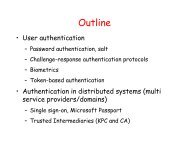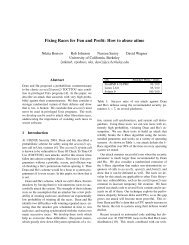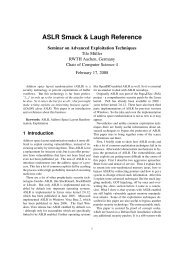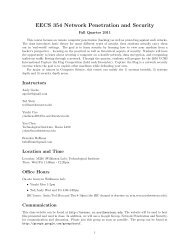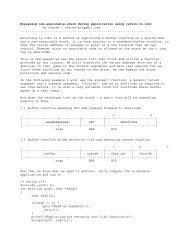Advanced Return to libc Exploits
Advanced Return to libc Exploits
Advanced Return to libc Exploits
Create successful ePaper yourself
Turn your PDF publications into a flip-book with our unique Google optimized e-Paper software.
6.1.2) during normal course of execution, the attacked binary copies<br />
user-provided data in<strong>to</strong> a static (preferably) or malloced variable.<br />
----[ 6.2 - Building the exploit<br />
We will try <strong>to</strong> emulate the code in dl-resolve.c sample exploit. When<br />
a rwx memory area is prepared with mmap (we will call mmap with the help of<br />
ret-in<strong>to</strong>-dl), we will strcpy the shellcode there and return in<strong>to</strong> the copied<br />
shellcode. We discuss the case of the attacked binary having been compiled<br />
without -fomit-frame-pointer and the "frame faking" method.<br />
We need <strong>to</strong> make sure that three related structures are placed properly:<br />
1) Elf32_Rel reloc<br />
2) Elf32_Sym sym<br />
3) unsigned short verind (which should be 0)<br />
How the addresses of verind and sym are related ? Let's assign <strong>to</strong><br />
"real_index" the value of ELF32_R_SYM (reloc->r_info); then<br />
sym is at SYMTAB+real_index*sizeof(Elf32_Sym)<br />
verind is at VERSYM+real_index*sizeof(short)<br />
It looks natural <strong>to</strong> place verind at some place in .data or .bss section<br />
and nullify it with two strcpy calls. Unfortunately, in such case<br />
real_index tends <strong>to</strong> be rather large. As sizeof(Elf32_Sym)=16, which is<br />
larger than sizeof(short), sym would likely be assigned the address beyond<br />
a process' data space. That is why in dl-resolve.c sample program (though<br />
it is very small) we have <strong>to</strong> allocate a few tens of thousands (RQSIZE) of<br />
bytes.<br />
Well, we can arbitrarily enlarge a process' data space with setting<br />
MALLOC_TOP_PAD_ environ variable (remember traceroute exploit ?), but this<br />
would work only in case of a local exploit. Instead, we will choose more<br />
generic (and cheaper) method. We will place verind lower, usually within<br />
read-only mmapped region, so we need <strong>to</strong> find a null short there. The<br />
exploit will relocate "sym" structure in<strong>to</strong> an address determined by verind<br />
location.<br />
Where <strong>to</strong> look for this null short ? First, we should determine (by<br />
consulting /proc/pid/maps just before the attacked program crashes) the<br />
bounds of the memory region which is mmapped writable (the executable's<br />
data area) when the overflow occurs. Say, these are the addresses within<br />
[low_addr,hi_addr]. We will copy "sym" structure there. A simple<br />
calculation tells us that real_index must be within<br />
[(low_addr-SYMTAB)/16,(hi_addr-SYMTAB)/16], so we have <strong>to</strong> look for null<br />
short within [VERSYM+(low_addr-SYMTAB)/8, VERSYM+(hi_addr-SYMTAB)/8].<br />
Having found a suitable verind, we have <strong>to</strong> check additionally that<br />
1) sym's address won't intersect our fake frames<br />
2) sym's address won't overwrite any internal linker data (like strcpy's<br />
GOT entry)<br />
3) remember that the stack pointer will be moved <strong>to</strong> the static data area.<br />
There must be enough room for stack frames allocated by the dynamic<br />
linker procedures. So, its best (though not necessary) <strong>to</strong> place "sym"<br />
after our fake frames.




